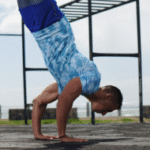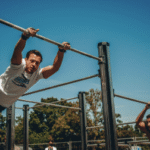Understanding Periodization for Long-Term Calisthenics Success
- What is Periodization? The Blueprint for Progress
Periodization is a systematic, pre-planned approach to organizing training variables (like volume, intensity, exercise selection, and frequency) over specific cycles of time. Its primary goal is to optimize adaptations, prevent overtraining, reduce injury risk, and ensure an athlete can reach peak performance at desired times. While originating in Olympic sports, its principles are universally applicable to any fitness goal, including calisthenics.
In essence, periodization acknowledges that your body cannot continuously progress at maximum intensity. It needs planned variations in stimulus and dedicated recovery phases to adapt and grow stronger.
- Why Periodization is Crucial for Long-Term Calisthenics Success
Calisthenics, by its nature, demands precise skill acquisition and a high strength-to-weight ratio. Periodization addresses these unique demands:
Avoiding Plateaus: The body adapts quickly to consistent stimuli. Without planned changes in training variables, you’ll inevitably hit a plateau where progress stalls. Periodization constantly introduces new stimuli, forcing your body to adapt and continue progressing. For calisthenics, this means intelligently varying exercise variations, rep ranges, tempo, and rest.
Preventing Overtraining and Injuries: Calisthenics, especially advanced skills, places significant stress on joints, tendons, and the central nervous system. Without planned deloads and recovery phases, chronic fatigue, burnout, and overuse injuries (e.g., elbow tendonitis, wrist strain, shoulder impingement – common issues for those pushing too hard in Houston gyms or parks) become highly likely. Periodization systematically integrates recovery, allowing your body to repair and supercompensate.
Optimizing Adaptation and Recovery: Periodization ensures that different physiological adaptations (e.g., hypertrophy, maximal strength, muscular endurance, skill acquisition) are emphasized at appropriate times, building upon each other. It respects the body’s need for recovery, leading to more sustainable and effective gains.
Skill Mastery and Progressive Overload: In calisthenics, “progressive overload” means making exercises harder by altering leverage, stability, or range of motion, not just adding weight. Periodization structures this progression. It breaks down complex skills (like the handstand, muscle-up, planche, or front lever) into manageable, sequential steps (e.g., accumulating foundational strength, then working on specific drills, then combining elements). This systematic approach makes seemingly impossible feats attainable.
Sustained Motivation: Continuous progress is a powerful motivator. By providing a clear roadmap and preventing stagnation, periodization keeps you engaged and committed to your calisthenics journey for the long haul.
- Key Concepts in Periodization for Calisthenics
Periodization is structured hierarchically:
Macrocycle: The longest training period, typically 6-12 months (or even several years for elite athletes). This defines your ultimate long-term calisthenics goal (e.g., achieving a freestanding handstand push-up, or a full planche).
Mesocycles: Intermediate training cycles, usually 4-12 weeks (1-3 months), within a macrocycle. Each mesocycle has a specific, concentrated training focus (e.g., a “hypertrophy block” for building muscle mass, a “strength block” for increasing maximal force, a “skill acquisition block” for dedicated handstand drills, or a “mobility block”).
Microcycles: The shortest training cycles, typically 1 week. This represents your weekly training schedule, detailing specific workouts, exercises, sets, reps, intensity, and rest. Microcycles are adjusted frequently to adapt to daily performance and recovery.
Phases of Training: Within mesocycles, training often cycles through phases:
Preparatory/Accumulation: Higher volume, lower intensity, focus on building work capacity, foundational strength, and hypertrophy.
Intensification/Strength: Lower volume, higher intensity, focus on maximal strength and specific skill progressions.
Peaking: Very low volume, high intensity, brief, used before a competition or a specific “test day” for a skill. (Less common for general calisthenics).
Deload/Active Recovery: Planned periods of reduced volume and intensity to allow for recovery and adaptation. This is crucial for preventing overtraining.
- Models of Periodization and Their Application in Calisthenics
Different models structure how volume and intensity change over time:
Linear Periodization (Traditional):
Concept: Intensity gradually increases while volume gradually decreases over a mesocycle. For calisthenics, this might mean starting with higher reps of easier variations (e.g., incline push-ups), then progressing to lower reps of harder variations (e.g., regular push-ups, then decline push-ups).
Application: Simple and predictable, often good for beginners building a foundation.
Non-Linear or Undulating Periodization (DUP – Daily Undulating Periodization / WUP – Weekly Undulating Periodization):
Concept: Involves frequent changes in training variables (volume, intensity) within a microcycle (week) or even within a single workout session.
Application: More complex but allows for simultaneous development of multiple qualities (e.g., a “hypertrophy day,” a “strength day,” and a “skill day” all in one week). This is highly effective for calisthenics, where you often need to develop strength, endurance, and specific skills concurrently.
Block Periodization:
Concept: Divides the macrocycle into distinct, sequential “blocks,” each with a concentrated training stimulus for a specific physical quality (e.g., a 4-week block solely for hypertrophy, followed by a 4-week block solely for maximal strength, then a 4-week block for skill integration).
Application: More specialized and advanced, allows for focused adaptation, often used by athletes aiming for specific calisthenics competitions or highly challenging feats.
- Implementing Periodization in Private Calisthenics Sessions (The Coach’s Role in Houston)
A private calisthenics coach in Houston is invaluable for implementing effective periodization:
Initial Assessment & Goal Setting: The coach assesses your current fitness level, identifies strengths and weaknesses, and works with you to define clear, measurable long-term calisthenics goals (your macrocycle).
Tailored Program Design: They design mesocycles (e.g., 4-6 week blocks) with specific focuses (e.g., a “foundational strength” block, followed by a “skill-specific conditioning” block, then a “peak performance” block).
Microcycle Creation: They break down each mesocycle into weekly (microcycle) workouts, carefully planning exercises, reps, sets, tempo, rest periods, and progression strategies.
Dynamic Adjustments: A private coach is adept at making real-time adjustments based on your daily performance, recovery, and any external stressors (e.g., a demanding work week in Houston). If you’re over-recovering, they might increase intensity; if under-recovering, they might dial it back or implement an unplanned deload.
Integration of Recovery and Nutrition: Periodization is not just about training; it’s about the entire adaptation process. A coach will provide guidance on proper nutrition (or refer to an RDN in Houston when appropriate) and emphasize adequate rest and sleep.
Injury Prevention: By systematically varying intensity and volume, and incorporating planned deloads, the coach significantly reduces the risk of overuse injuries that can plague unperiodized calisthenics training.
Client Education: The coach educates the client on why periodization is necessary and how their body adapts, empowering them with a deeper understanding of their training.
- Benefits for Houston Calisthenics Practitioners
For those pursuing calisthenics in Houston, where lifestyles can be demanding and goals varied, periodization offers:
Sustainable Progress: Continually make gains without burning out.
Injury Resilience: Train hard and safely, minimizing time off due to injury.
Goal Achievement: Systematically work towards complex skills like handstands, muscle-ups, or planches.
Optimal Adaptation: Ensure your body gets the right stimulus at the right time.
Time Efficiency: Maximize results from your workouts, fitting effective training into a busy Houston schedule.
Mental Freshness: Avoid monotony and training burnout by varying routines and focusing on different aspects of fitness.
In conclusion, understanding and applying periodization is a non-negotiable for anyone seeking long-term calisthenics success. It provides the scientific framework to intelligently structure your training, prevent plateaus, manage fatigue, and systematically progress towards even the most challenging bodyweight feats. A private calisthenics coach in Houston is perfectly positioned to custom-design and implement this strategic approach, transforming aspirations into tangible, sustainable achievements.

Understanding Periodization for Long-Term Calisthenics Success
Route
Calisthenics Gym Houston Functional Bodyweight Training
Secondary phone: (346) 483-3195
Email: info@calisthenicsclubhouston.com
URL: https://calisthenicsclubhouston.com/
Monday 6:00 AM - 7:00 PM Tuesday 6:00 AM - 7:00 PM Wednesday 6:00 AM - 7:00 PM Thursday 6:00 AM - 7:00 PM Friday 12:00 PM - 6:30 PM Saturday 9:45 AM - 12:00 PM Sunday 3:00 PM - 5:00 PM





